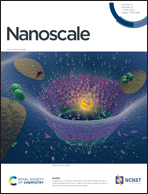Raman inks based on triple-bond-containing polymeric nanoparticles for security†
Abstract
Developing security inks with spectral outputs/multiple colors, which have unique identification characteristics, is of great importance in enhancing the anti-counterfeiting strength of ink anti-counterfeiting technology. Herein, a print-driven triple-bond coding mode is proposed for the first time. Two kinds of triple-bond-containing polymeric nanoparticles (NPs) with Raman shifts at 2227 and 2241 cm−1 have been designed into printable ink, and the decimal coding output can be easily obtained by reasonably adjusting the proportions of the two polymeric NPs. Single Raman scattering inks can be used as invisible inks to print monochromatic patterns and words that the decoder can read out. According to the two-dimensional pixels of the graphics decoder, invisible colorful graphics can be printed with mixed inks under different polymer proportions. More interestingly, three-dimensional invisible patterns with stronger anti-counterfeiting strength can also be obtained in the double-layer anti-counterfeiting patterns with different proportions of ink by the spatial complementary coding mode. It is predicted that more security inks associated with triple-bond Raman signals will spur the application of the anti-counterfeiting field.



 Please wait while we load your content...
Please wait while we load your content...